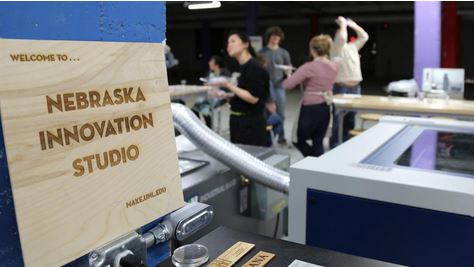
This is the true story of 23 UNL students from various academic backgrounds, picked to work together and learn about new technologies; to find out what happens when people start tinkering and begin to develop bigger ideas.
This is "Making for Innovation," a unique, first-time UNL course offered in the new Innovation Studio at Nebraska Innovation Campus.
The class, which is worth three credit hours and meets for lectures on Tuesdays and lab projects on Thursdays, is taught by Shane Farritor, professor of mechanical and materials engineering, and Liana Owad, a UNL graduate with a Master of Fine Arts.
"It is going much better than I ever dreamed possible," Farritor said. "It's been exciting watching these students come together from their various perspectives and solve problems."
Participating students represent 10 disciplines, including mechanical engineering and applied mechanics; electrical engineering; agricultural and biological systems engineering; architecture; textiles, merchandising and fashion design; art; chemical engineering; music; and marketing.
The course is designed on two basic ideas: building and hands-on problem solving are important paths to innovation; and that innovation occurs at the boundary between humanities and technology.
“We are each sharpening our ability to be creative,” said Tanar Fairchild, a chemical engineering major. “That’s a tool that will be useful in any area of study or future career.”
Class presentations and lab projects allow the students to learn about and use the tools offered in the Innovation Studio, formerly called the Maker Space.
During the first week of March, the students worked with UNL’s Stephen Morin, assistant professor of chemistry, to build soft, flexible robots powered by bursts of air.
Other semester lab topics range from crafting an apron on a sewing machine and learning computer-aided drawing software, to running a computer-controlled router and working to build an electronics platform.
The lessons build toward a final project that requires students to make something using techniques outlined during the semester.
"When I started in this class, I had no background on how to use almost all of these machines," said Breanne Reiss, a master's student in textiles, merchandising and fashion design. "But this course seemed like a friendly way to learn new skills and to collaborate with people who are more comfortable in these different areas."
The class has inspired Reiss to think beyond her regular textile designs for the final project. She plans to create a dress that uses technology to reconfigure and fit different situations or desires.
"My project is based on a design by Issey Myacke that uses pull chords within the dress to gather the fabric up in different ways," Reiss said. "I thought it would be cool if you could do that with just a tap of a button."
She initially thought of using motors to achieve the effect, but revamped her plan after learning about more advanced technologies in the Innovation Studio course.
"The motors would have been too heavy," Reiss said. "But I found this wire that contacts with electricity. I never knew that kind of thing existed before this class."
Other planned projects include crafting an automated foosball table, building a custom guitar amplifier, making a cold brew coffee system and designing a 3-D printer that crafts ceramics.
The students are allowed to design and build the projects on their own or collaborate with others as needed.
"Ideally, we would like to see the students come together on these final projects," Farritor said. "All of the projects start from scratch and are to be custom builds. We hope that each one stretches the skills of students involved."
While the course is in full swing, it marks the initial phase for UNL's Innovation Studio, which is on the first floor of the old 4-H Building at Nebraska Innovation Campus.
The 16,000-square-foot space will eventually include several areas for "making," including rapid prototyping, art and electronics. UNL officials hope to make part of the space available to students, faculty, staff and the public as early as July.
"Teaching this class and getting the equipment up and running is phase zero for Innovation Studio," Farritor said. "We are moving toward phase one, which will build out a space on the south end, include the equipment we have on hand and maybe a couple other items, and open to general membership."
Access to the space will be controlled similar to that of a recreation center, with memberships offered at different rates for students, faculty, staff and the public. Additional details will be released as the space is developed.
In the meantime, students enrolled in the "Making for Innovation" course will continue to develop new skills and show the potential of the maker space.
"As an engineer, this class is like being on an exclusive tour of Willie Wonka's factory," said Fairchild. “I can't wait for this space to open up to the public.
“Honestly, it's going to be difficult for me to stay away because I'm getting kind of addicted to being able to come in and create."
Written by: Troy Fedderson, University Communications